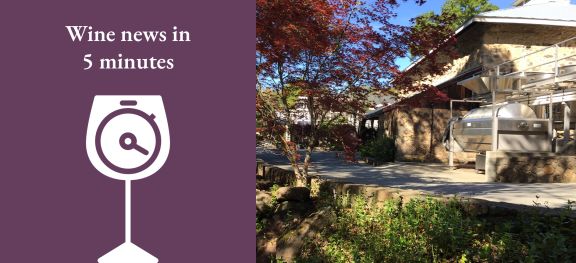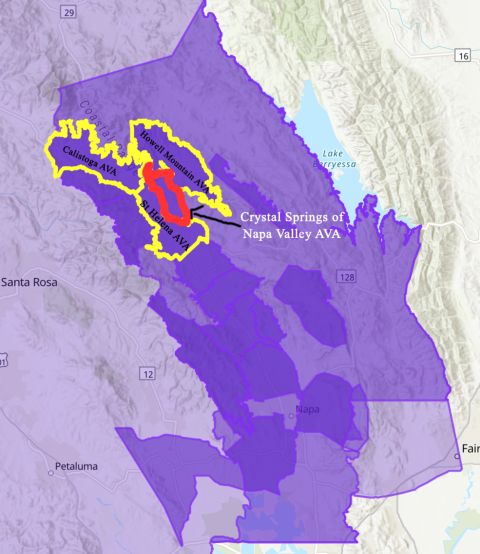Napa's new AVA, a massive wine-fraud bust, UK harvest woes, hidden sugar in 'dry' wine

Plus musings on Hong Kong’s liquor-duty slashing as incentive to revive its nightlife. Above, Bremer Family Winery, one of the wineries within California's new Crystal Springs of Napa Valley AVA.
Napa’s newest AVA
On 15 October the TTB approved the first new AVA in Napa Valley in 13 years: Crystal Spring of Napa Valley AVA. The new AVA covers the gap between the easternmost portions of the Calistoga and St Helena AVAs and the 1,400-ft elevation where the western flank of the Howell Mountain AVA begins. The boundaries of the new AVA cut slightly into the Calistoga AVA and, where the two would overlap, what was previously Calistoga will now be Crystal Springs of Napa Valley AVA.
The area outlined encompasses 4,000 acres (with approximately 230 acres (93 ha) of vineyards currently), ranges in elevation from 400 to 1,400 ft (122–427 m), slopes graded from 15% to 40%, west to south-west exposure, high diurnal temperature swings, and mainly volcanic bedrock with some metamorphic and sedimentary material.
The author of the proposal, Steven Burgess, previously the owner of Burgess Cellars, told me that he was nearly finished with the proposal in 2016 when his father passed away and he put it on hold. He finally had the time to finish the proposal in 2020 – just prior to selling Burgess Cellars to Lawrence Wine Estates. Despite the fact that he is no longer a vintner (he currently works for Napa Firewise) he said he still has a vested interest in the area being recognised, owns an unplanted piece of property in the AVA, and thinks that the area makes some of the most unique wines in the Napa Valley.
There are around 30 commercial vineyards in the AVA – though the only wineries within its boundaries are Viader, Bremer Family Winery and Somnium. Bob Bolan, winemaker for Bremer Family Winery, told me that the Bremer team is in favour of the AVA and that it will be nice to be able to label their wines from their vineyards outside the Howell Mountain AVA with ‘a bit more clarity’ than the larger Napa Valley AVA provides. Delia Viader emailed to say that Viader will not use the AVA. Burgess says that he’s talked to Dana Estates, Zakin Estate and Seven Stones Winery – who all source fruit from or own vineyards in the AVA – and all seem enthusiastic at the prospect of using the designation.
Tough vintage in the UK
Decanter put out a bleak report on 17 October that started out referencing records from the Department of Environment, Food and Rural Affairs that show that the UK’s wet, cool summer led to its second-worst harvest (with reference to all crops grown) since records began. Estimates for grape yields are not yet available, as most producers just began harvesting this week, but the publication cited a likely decrease of 20–70%, mainly due to high fungal pressure. Will Perkins, head winemaker at Vranken Pommery’s Pinglestone estate is quoted as saying, ‘From January through to today, we haven’t had a window of more than six days without rain’.
The silver lining I’m going to put on this is that the 2023 harvest in the UK was absolutely massive, the majority of what’s produced in the UK is sparkling – which by its nature is far more forgiving of a cold vintage than still wines, and, because it’s sparkling, consumers are much more conditioned to accept non-vintage blends. So, while the 2024 vintage is incredibly challenging, I’m hopeful that UK producers will be able to balance their finances between a bumper year and one that is less than ideal while still making good wine.
International wine-fraud ring dismantled
On 14 October a wine-fraud ring in Italy was shut down as a result of the combined efforts of the French Gendarmerie (Gendarmerie Nationale), Italian Carabinieri Corps (NAS Carabinieri), Swiss Federal Police (Police Federale Swiss), Europol and Eurojust. €1.4 million of equipment and €100,000 in cash and documents were seized and six people were arrested.
The criminals were counterfeiting French Protected Designation of Origin (PDO) wines in Italy and sending them all over the world. Apparently, the case was connected to a separate case that was closed in 2015. The investigations for the case that closed this week have been ongoing since 2019.
Details on this are pretty sparse. The BBC and The Drinks Business have both covered the case but I haven’t seen much that expands beyond the original report. I had hoped to hear more details about the wines counterfeited and where they ended up.
How much sugar is in that wine?
Next, a humorous letter from Constellation’s lawyers –
Now, this isn’t the hardest-hitting news … but it is funny.
Adam Lee, who founded Siduri Wines, sold it to Jackson Family Wines, and has since founded numerous other wine labels, ran a Facebook advertisement in February 2024 for one of his wines named Dial Tone. The ad showed one bottle of Meiomi Pinot Noir next to 32 bottles of Dial Tone Pinot Noir and read, ‘There is less sugar in 32 bottles of Dial Tone Pinot Noir than in just 1 bottle of Meiomi Pinot Noir. Drink what you like. Know what you’re drinking.’ He then wrote a blog post detailing the results he received from ETS Lab, where he sent Meiomi to be tested, and they came back with 19.4 g/l of residual sugar to Dial Tone’s 0.6 g/l.
A store on the Kansas–Missouri border, Ranchmart Wine & Spirits, took Lee’s ad and turned it into an in-store display.
Then, last month, Lee got a letter from Constellation’s lawyers – Constellation owns Meiomi – demanding that he provide evidence and suggesting that his ad may violate a federal law prohibiting false advertising. Lee sent them the lab reports.
Now, I have absolutely nothing against sweet wine – I drank a glass of Sauternes after dinner last night – but I agree with Lee that most consumers don’t know that many supermarket brands that are thought of as ‘dry wine’ contain residual sugar. This whole interaction illustrates two things for me. One, the US should follow in the EU’s footsteps and use nutritional labelling to illustrate sugar content – even if it is only available via QR code. And two, Constellation’s lawyers have never drunk Meiomi Pinot Noir.
Hong Kong slashes liquor duties
Hong Kong’s nightlife is suffering. Official data show that bar sales had dropped 28% in the first half of 2024 compared with the same period in 2019. As a result, on 16 October, Hong Kong slashed liquor duty from 100% to 10% in an effort to reinvigorate nightlife. This move was in part motivated by the fact that, after wine duties in Hong Kong were abolished in 2008, wine imports jumped 80% in a year.
I’m personally very sceptical as to whether this strategy will work. Hong Kong has changed significantly since 2008. In 2020 China imposed a National Security Law (NSL) on Hong Kong in response to 2019 protests against an extradition bill. That NSL is widely seen to have eroded the freedom and pro-democracy culture that Hong Kong previously enjoyed – resulting in mass emigration. More than 200,000 people left the city between mid 2019 and mid 2022 and tourism has lessened. The city has also seen a decline in local spending as more Hong Kong residents spend weekends in mainland China where prices are cheaper. I just don’t think that slashing duties can bring back the culture that was responsible for the more vibrant nightlife.
That’s all for this episode of the wine news. If you enjoy this newscast and would like to see it continue, please subscribe to JancisRobinson.com. And if you have breaking news in your area, please email news@jancisrobinson.com.
Photo at top courtesy Bremer Family Winery.
This is a transcript of our weekly five-minute news broadcast, which you can watch below. You can also listen to it on The Wine News in 5 Podcast. If you enjoy this content and would like to see more like it, please subscribe to our site and our weekly newsletter.
Become a member to view this article and thousands more!
- 15,414 featured articles
- 275,126 wine reviews
- Maps from The World Atlas of Wine, 8th edition (RRP £50)
- The Oxford Companion to Wine, 5th edition (RRP £50)
- Members’ forum
- 15,414 featured articles
- 275,126 wine reviews
- Maps from The World Atlas of Wine, 8th edition (RRP £50)
- The Oxford Companion to Wine, 5th edition (RRP £50)
- Members’ forum
- 48-hour preview of all scheduled articles
- Commercial use of our wine reviews

